Abstract
Sustainability and a circular economy (CE) are crucial for the development of society. The CE approach should start by designing new products or processes or retrofitting existing ones to achieve the best efficiency and extend their life cycle. Designs that enable CE require the guidance of a design theory. Axiomatic design (AD) theory allows for the classification of designs and achieving the targets if appropriate requirements are adopted. This paper aimed to show that sustainability and productivity can be made compatible by ensuring functional independence, as defined in AD and using the circular economy concept. The paper presents how a salt washing machine could be improved concerning its performance. The analysis of the existing design showed fewer design parameters than the functional requirements. A viable enhancement was the addition of one design parameter, which made it possible to control the separation and washing independently. The resulting machine retrofitting increased the production rate by 20% to 30%—the productivity and the quality of the final product was also improved. The washing process now used less water and energy. Moreover, the brine feeding system was also redesigned, so that the brine was now reused, the land use was reduced as was the operating time, and the operators now worked in a more friendly environment. The industrial case study presented in this paper is an example of how innovative engineering design that fits the design science research (DSR) with the generation of knowledge. The objective of this design solution was to increase the efficiency of the entire process and consequently increase the productivity and sustainability.
1. Introduction
The application herewith presented is the overall upgrading of an already existing salt washing process to make it consistent with the circular economy (CE). The washing process works with salt-saturated brine, obtained by the evaporation of seawater, and includes a salt washing machine, whose specific improvement consists of conforming it with the AD’s independence axiom, as described in a previous paper [1]. Nonetheless, this paper describes the matching of the upgraded washing machine with the brine recycling subsystem, which also conforms to the AD’s independence axiom, and makes the whole washing process much more sustainable because it becomes closer to the circular economy concept.
The circular economy became a relevant societal issue in 2002 after the publication of the book Cradle to Cradle: Remaking the Way We Make Things [2]. According to the Ellen MacArthur Foundation, “a circular economy is a global economic model that decouples economic growth and development from the consumption of finite resources. It is restorative by design and aims to keep products, components, and materials at their highest utility and value, at all times” [3].
We are facing a paradigm shift: investing in the design, so that there is no waste, instead of investing in the use of waste. Keeping material cycles clean is the objective of the circular economy. It implies preserving the function and value of the products, components, and materials at the highest possible level as well as extending their lifespan.
The transition from a linear to circular economy implies changing the concept of what a product is. The product becomes a functionality/performance source rather than an added value item, and the business model now incorporates the end-of-life of the product [4].
In this context, products and their manufacturing processes typify the development of the circular economy. Product design determines the feasibility of assembly and manufacturability in a linear economy. Additionally, product design and the manufacturing process design determine the potential to achieve circularity.
This paper presents an interpretation of the productivity of manufacturing systems from the circularity point of view. After a brief note about the inclusion of design in the circularity endeavor, the design science research of vom Brocke et al. [5] and the AD principles are presented to support this approach. Next, the retrofitting of a salt washing process was conducted by using the AD principles. The process was also improved so that the new solution reused the brine that became contaminated after the washing process. Consequently, it reduced the use of resources, namely, seawater, land area, and time. Finally, the paper presents the results and conclusions of the contribution of axiomatic design principles to move toward a circular economy through the growth of productivity, if this is attained by ensuring functional independence. The example presented in this paper shows that engineering design based on a design theory can solve technical problems and create scientific knowledge related to the circular economy.
2. The Perspective of Manufacturing Systems under the Circular Economy Point of View
The design of production systems involves the production process and production management. The former concerns the manufacturing technologies and materials flow and handling, and the production management focuses on the flow of information and signals. One must plan these two areas to perform according to the specified needs [6]. Additionally, good production management requires that the selected conceptual solutions for the whole process result from a set of independent functional requirements, ensuring the robustness of the process.
On the other hand, any manufacturing system aims to maximize productivity [6], as defined by Equation (1).
Productivity increases by increasing the total added value or decreasing the production costs or investment. Regarding the business operations, the added value of a product (or process or service) is created by its functions, performance, suitability, quality, and price [1]. The added value from Equation (1) results from the activities developed in several areas, which relate to the marketing and sales, product development, manufacturing, assembly, quality, and logistics.
Regarding the manufacturing processes, two modes allow for the increase in the added value: (1) a better use of available time, which means obtaining more value through the rise in the produced quantities per time unit; and (2) an enhanced quality of the manufacturing operations, which enables getting the specified functions right the first time [6].
Integrating life cycle costs by adding the production costs, total investment, environmental, and societal costs lead to sustainability. A circular economy (CE) is a crucial strategy for sustainability. The added value must be reached via functional performance regarding the contribution to the environment and society. The current model of valuing technical features and added value to the economy does not relate to sustainability. Technological solutions that imply the rationalization of the use of natural resources and allow for the substitution of components to increase the life of manufacturing systems meet the purposes of a CE. This paper shows that productivity and circularity are not antagonistic by using the example of an industrial process.
3. A Brief Perspective of Product Design towards the Circular Economy
The current literature essentially presents two approaches of product design toward a circular economy.
The first is a significant number of design guidelines based on Design for X (Design for disassembling, modularity, maintainability, etc...). The guidelines are technical recommendations for decision-making through the different design steps [7,8]. They denote a set of wishes such as long-life products, easy recycling, product-oriented services, and materials and energy sustainability.
The second approach relies on several indicators (usually designated by c-indicators) that quantify the evolution toward circularity during the design and development process. It is accepted that c-indicators are important to assist and monitor the CE transition [9]. The objective is to consider all possible iterations of the circular economy processes.
Despite the many design guidelines and c-indicators, there is a lack of theories that can support decision-making throughout the design process toward circularity [10]. This paper was based on the following assumption: uncoupled or decoupled designs—according to axiomatic design theory—are good designs in terms of efficiency, and, consequently, they are good in terms of productivity and sustainability. This assumption was based on the empirical observations on the effect of independence. Since the general validity of the assumption was not demonstrated at this time, the increase in efficiency was observed in many real cases. This was expected due to AD’s independency axiom.
Bearing in mind product design as a key thought toward a circular economy, one has to look at engineering design as a scientific subject, since it follows an approach other than “routine design”. This allows for the creation of scientific knowledge from the product, from the approach, or from both.
4. Engineering Design as a Scientific Subject
4.1. The Basics of Design Science Research
Design science research is an approach to support the solution of problems through the development of innovative artifacts, which leads to new design knowledge and to the understanding of the problems [5]. This approach allows the questions presented by the sciences of the artificial to be answered, as expressed by Herbert Simon, when he said “… we introduce ‘synthesis’ as well as ‘artifice,’ we enter the realm of engineering. For ‘synthetic’ is often used in the broader sense of ‘designed’ or ‘composed.’ We speak of engineering as concerned with ‘synthesis,’ while science is concerned with ‘analysis.’ Synthetic or artificial objects and more specifically prospective artificial objects having desired properties are the central objective of engineering activity and skill. The engineer, and more generally the designer, is concerned with how things ought to be how they ought to be in order to attain goals, and to function.” [11] (p. 4).
There are some models concerning DSR, generally presented for application in information systems [12], which are appropriate for engineering design in general, and even to improve engineering education research [13]. However, “In case knowledge is already available to solve a problem identified, this knowledge can be applied following ‘routine design,’ which does not constitute DSR” [5]. By ‘routine design’, one means that the conceptualization of the design is developed using codes or algorithms.
As mentioned in [5], the design science research model proposed by Peffers et al. [14] is the most widely referred. This model is composed of six steps called activities:
Activity 1: Problem identification and motivation, where the specific research problem is defined and the chosen solution is justified.
Activity 2: Definition of the solution objectives that come from the problem definition as well as the previous knowledge about what is possible and feasible.
Activity 3: Design and development where the artifact is created.
Activity 4: Demonstration, where the use of the artifact is shown as a means to solve one or more instances of the problem.
Activity 5: Evaluation, where how well the artifact fits the chosen solution is observed and measured.
Activity 6: Communication of the problem and its importance, of the artifact and its utility and novelty, of the design accuracy as well as of its effectiveness to researchers and other relevant audiences such as practicing professionals, when appropriate.
4.2. The Basics of Axiomatic Design
In the axiomatic design (AD) terminology, the design is made along with the four design domains: the customer, the functional, the physical, and the process domains [15] (p. 10).
These domains are shown in Figure 1 and, according to Gummus et al. [16], their contents can be described as follows:

Figure 1.
The axiomatic design domains, their contents, and relationships.
“Customer Domain”: Contains the Customer Needs (CNs) (i.e., the attributes that the customer seeks in the product or in the system that must be designed).
“Functional Domain”: Contains the Functional Requirements (FRs) of the design object. In a good design, they are the minimum set of independent requirements that completely describe the functional essentials of the design solution. In any new design, the FRs should be defined in a solution-neutral manner. Reverse engineering, however, has no theoretical foundation, because one cannot infer the FRs by just looking at the DPs. In other words, “FRs can only be guessed” [17] (p. 205).
“Physical Domain”: Contains the Design Parameters (DPs) of the design solution. The DPs are the elements of the design solution that are chosen to satisfy the specified FRs.
“Process Domain”: Contains the Process Variables (PVs) that characterize the production process of the design solution (i.e., the variables that allow for the specified DPs to be attained).
For each pair of adjacent domains in Figure 1, the left one represents “What is required to achieve”, or the goals, while the right domain focuses on “How to achieve the goals”, that is, the design solution. This is conducted by mapping between the goals and the way to achieve them.
The existing constraints to this mapping are the bounds for the acceptable solutions and are classified as “input” and “system” constraints [15] (p. 14). The input constraints are defined at the start of the design process, and the system constraints are found during the design process.
The conventional product design process starts by selecting the higher level FRs and DPs and qualitatively evaluating the probability of success of such a solution. This procedure allows for unworkable solutions to be discarded before trying any more detailed development. “Because the final design cannot be better than the set of FRs that it was created to satisfy” [18] (p. 26), then seeking a proper set of FRs is the first step to finding a good solution.
The following sections present some high-level solutions with their qualitative appreciations.
A unique concept in AD is the hierarchical decomposition by zigzagging between contiguous domains, as depicted by the red arrows in Figure 1. This decomposition advances in a top–bottom way, beginning at the system level, and continuing to levels of more detail, until enough detail is achieved so that all of the stakeholders are satisfied with the resulting design object.
Therefore, the decomposition defines the father/child relationships between the FRs belonging to different levels of the decomposition.
The fundamental hypothesis of AD is that two axioms govern good design practice:
- -
- The independence axiom (the first axiom):
- Maintain the independence of functional requirements.
- The first axiom means that adjusting each DP should just affect one FR.
- -
- The minimum information axiom (the second axiom):
- Minimize the information content of the design.
The second axiom’s purpose is to help find the alternative design solution with the minimum information content, which is the one with the highest probability of achieving the FRs.
The mapping between the FRs and DPs is denoted by Equation (2), the “design equation”, where {FR} is the “FR vector”, {DP} is the “DP vector”, and [A] is the “design matrix” (DM):
According to the independence axiom, the number of DPs should equal the number of FRs—Theorem 4 of AD states “In an ideal design, the number of DPs is equal to the number of FRs and the FRs are always maintained independent of each other” [19] (p. 45).
Uncoupled and decoupled solutions are characterized by diagonal and triangular design matrices, respectively [10,11,12]. Equation (3) depicts a 3-FR, 3-DP uncoupled design, and Equation (4) shows a decoupled design. Each × represents a significant element, all the others are zeros.
In the example of Equation (3), each FR is affected by just one DP. This means that every FR can be achieved independently from the others. In Equation (4), DP1 should be tuned first to achieve FR1, but this impacts on all of the other FRs. Next, DP2 could be tuned to attain FR2, but this also affects FR3. Finally, DP3 could be tuned to achieve FR3. Therefore, choosing the right order to tune the DPs allows for the FRs to be achieved as in the case of Equation (3) (i.e., as if they were independent).
Any DM that cannot turn into a diagonal or triangular matrix just by changing the positions of rows and/or columns corresponds to a “coupled” design and should be avoided, as per Theorem 4.
Since the design process does not necessarily lead to a unique solution, the information axiom should be used to compare the alternative solutions and select the one with the highest probability of achieving the FRs [20].
According to AD, coupled designs must be avoided or redesigned so that they become decoupled or uncoupled designs. Hence, a question arises: how do we turn coupled designs into decoupled or uncoupled designs?
Different approaches can be applied. For example, if the number of DPs is less than the number of FRs, one should make them equal. In fact, “When a design is coupled because of a larger number of FRs than DPs (i.e., m > n), it may be decoupled by the addition of new DPs so as to make the number of FRs and DPs equal to each other if a subset of the design matrix containing n x n elements constitutes a triangular matrix” (Theorem 2) [14] (p. 45). This was the approach applied in the example presented in this work.
The DM allows for the couplings to be identified and the DPs that cause the couplings must be changed. The design ranges should be made as large as possible, since increasing the design ranges can turn a coupled design into a decoupled or uncoupled one, as per Theorem 20: “If the design ranges of uncoupled or decoupled designs are tightened, they may become coupled designs. Conversely, if the design ranges of some coupled designs are relaxed, the designs may become either uncoupled or decoupled.” [19] (p. 47).
Additionally, “When a given set of FRs is changed by the addition of a new FR, by substitution of one of the FRs with a new one, or by the selection of a completely different set of FRs, the design solution given by the original DPs cannot satisfy the new set of FRs. Consequently, a new design solution must be sought” (Theorem 5) [19] (p. 45). Therefore, new solutions cannot be attained by the simple adjustment on DPs, and a complete reevaluation of the design is required. Theorem 5 focuses on a widespread design mistake. During the design process, new ideas come along. The simple question of “why not?” when trying to make the artifact perform an extra task is costly and baffling. Solving “why not?” by adding a new DP may turn the design into a coupled design.
The following tasks apply to the next sections:
- -
- Define the smallest number of FRs that describe the required design.
- -
- Define as many DPs as FRs. Parts may have more than one DP.
- -
- If the number of DPs is less than the number of FRs, seek extra DPs.
- -
- The design might be uncoupled or decoupled.
- -
- Try to change DPs, or challenge ranges to avoid couplings.
- -
- If new FRs are added, reevaluate the complete design.
Regarding the application of AD to assist CE, two approaches are feasible: (i) defining FRs that express the basics of CE and sustainability; and (ii) adopting Cs related to sustainability and CE to apply to designs where some FRs express economic and technical questions. This paper used the second approach since it is more suitable for the revamping of existing systems.
Based on the analysis of design matrices, one can infer that uncoupled and decoupled designs lead to increased efficiency. This happens because they prevent the losses that might come from couplings. These couplings do not exist in uncoupled designs and are easy to avoid in decoupled designs by choosing the appropriate order to adjust the DPs, as in the case of Equation (4).
5. The Case Study
5.1. The Industrial Salt Washing Process
The industrial process of sea salt harvesting in traditional crystallizer ponds collects a mixture of salt crystals and clay. The clay particles come from the bottom of the ponds. Figure 2 shows some of the aspects of the industrial sea salt harvesting process.
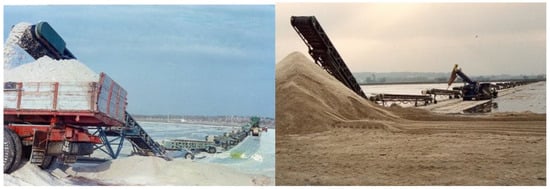
Figure 2.
The industrial sea salt harvesting process [1].
Building crystalline structures warrants no clay being inside the salt crystals, and one needs to separate the clay particulates from the crystals. The typical way to separate salt from the clay is to dilute the mixture through agitation in a liquid phase that does not dissolve the salt particulate. The liquid phase commonly used is an aqueous solution saturated with salt, called brine. Brine cannot dissolve more salt, thus balancing the salt that will likely dissolve and the salt that recrystallizes. Therefore, slow speed-controlled precipitation enables separation.
Figure 3 depicts the salt washing process through stirring. Quick stirring enables the mixture to be diluted, while slow steering separates the salt from the clay particulates.

Figure 3.
The scheme of the process of washing the salt [1].
Salt washing traditionally uses machines and a tank where the salt with clay is diluted in a salt-saturated brine. A screw conveyor shakes the mixture to disperse the brine’s clay and salt crystals. The screw conveyor rotation motion also splits the salt from the clay through separate drainage. The salt is removed from the washing tank through the underflow outlet at the higher side of the tank. The brine with clay leaves the tank through an overflow outlet on the lower side of the tank. Some examples of existing salt washing machines are depicted in Figure 4.

Figure 4.
Examples of salt washing machines with screw conveyors [1].
5.2. Axiomatic Design Analysis
The adopted strategy was to understand the actual process and guess the FRs. There is empirical evidence that the efficiency of systems increases with the independence of the functionalities. According to AD, one must carefully define the design’s main goals at the onset of the process. The design process can proceed only after clearly stating those goals [21].
Figure 5 shows the primary customer need: to separate the clay from the valuable washed salt.

Figure 5.
The Customer Needs to separate the clay from the salt—Customer Domain [1].
From the Customer Needs, the high-level function at the first hierarchical level is:
FR1—Wash salt
Corresponding in the physical domain to:
DP1—Salt washing machine
On the second level of decomposition, it is necessary to accept the mixture of salt with clay (FR11), dilute the mixture (FR12), extract the clay (FR13), and segregate the salt (FR14). Figure 6 schematically shows the ideation of the FRs.

Figure 6.
The functional requirements to separate the clay from the salt (Functional Domain) [1].
Figure 7 represents the solutions (DPs) to achieve the above-mentioned functions (FRs) in the physical domain. Each FR requires a DP to be fulfilled. In the machine under analysis, the DPs are the washing tank (DP11), brine (DP12), and screw conveyor (DP13). The screw conveyor should allow for FR13 and FR14 to be achieved.

Figure 7.
The design parameters and functional requirements of a traditional salt washing machine (adapted from [1]).
Table 1 summarizes the described rationale of the design. The table shows the first and the second levels of decomposition. The table also shows the third level of decomposition regarding FR11.

Table 1.
The FR-DP decomposition.
The input Cs to improve the salt process toward sustainability are as follows:
Cs1—Use a certain area of land.
Cs2—Limit the use of energy.
Cs3—Restrict the work on weather conditions.
As a system constraint, Cs4—No salt should dissolve in the process.
Table 1 shows that the design violates Theorem 1, as the number of DPs is less than the number of FRs.
Figure 8 shows the FRs and DPs as they occur along with the salt washing machine. Figure 9 displays a traditional salt washing machine.
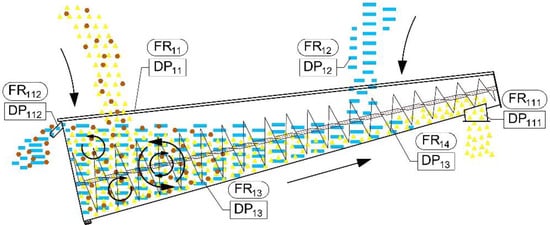
Figure 8.
The FRs and DPs along with a traditional salt washing machine (adapted from [1]).
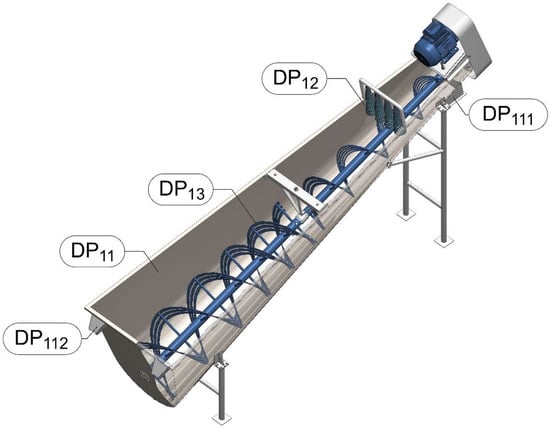
Figure 9.
The design parameters of a salt washing machine (Physical Domain) (adapted from [1]).
Figure 9 displays a traditional salt washing machine.
In the existing washing machine, the same DP, the rotating shaft, implements two FRs. These two functional requirements exhibit a coupling: the fast stirring of the mixture is required to extract the clay, while slow stirring allows for salt to be segregated.
Therefore, in Equation (5), the design matrix for the second hierarchical level has more FRs than DPs, so the design matrix is not square.
The third-level FRs are fulfilled independently and are not relevant to the following discussion.
As one can see, the traditional salt washing machines were coupled since the number of DPs was smaller than the number of FRs at the second level. Their functional requirements were never fully satisfied because one cannot sufficiently increase the shaft speed to warrant effective clay extraction. The shaft speed could not be as slow as required to avoid affecting the salt segregation. This coupling impedes the best use of the machine. To produce a certain quantity of washed salt, the amount of brine used and the time are larger than necessary, if the functional requirements of the machine are independent.
Hence, the design team decided to retrofit the machine by searching for a solution with independent FR13 and FR14.
5.3. The Retrofitting of the Washing Machine—Based on the Independence of Functions
The new solution divides the screw conveyor into two sections with independent rotation movement: a high-speed conveyor in the extraction section of the tank and a low-speed conveyor in the segregation section. Figure 10 shows the design parameters for a two-screw conveyor salt washing machine.
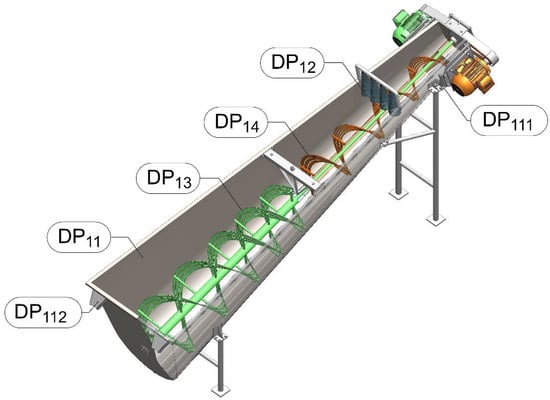
Figure 10.
A split screw salt washing machine and the DPs (Physical Domain) (adapted from [1]).
At the second hierarchical level, the design parameters of the new design were as follows:
- DP11—Washing Tank;
- DP12—Brine;
- DP13—Screw conveyor 1;
- DP14—Screw conveyor 2.
The salt and the clay find their way from conveyor Section 1 to conveyor Section 2 by themselves. The hierarchical zigzag decomposition is depicted in Figure 11.

Figure 11.
The zigzag path of the decomposition of a split screw salt washing machine (adapted from [1]).
As shown in Equation (6), the matrix became square, and the design decoupled.
5.4. The Process of Brine Recycling
As explained earlier, the salt washing process uses stirred salt-saturated brine to remove the clay from the surface of the salt crystals.
The mass of washed salt depends on the used amount of salt-saturated brine. The retrofitted washing machine required more brine than the original one due to its higher production rate.
The brine is produced from the seawater that enters large and shallow ponds to evaporate and increase the salt concentration. The free surface of those crystallizer ponds is huge, so they ensure a substantial solar energy absorption to grant a large evaporation rate. Figure 12 shows the process of producing brine by evaporation in two ponds with increasing salt concentration.
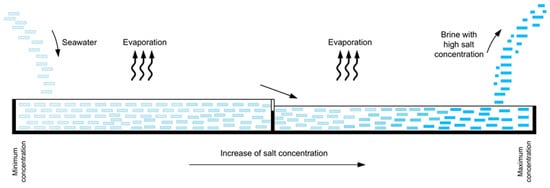
Figure 12.
The brine production process from seawater by evaporation.
The brine concentrating process is time-consuming. It requires a large land area, but the evaporation rate also depends on the weather conditions. Salt begins precipitating after the brine attains the point of salt saturation since the evaporation does not stop. The air temperature, humidity, and air velocity near the free surface of the ponds are of paramount importance. Additionally, the occurrence of rain over the ponds decreases the salt concentration in the brine, making salt harvesting a typical summertime activity. The lack of control over the weather conditions and the larger amounts of brine required by the improved washing machine dictated the review of the processes related to brine utilization.
The evaporation rate can be improved in several ways.
A conceivable way is to blow the free surface of the brine to increase the air velocity. For this purpose, the use of fans would be possible. In this case, the top FR and DP would be:
FR0—Increase the air velocity near the water surface.
DP0—Fans.
However, the energy consumption would be very high given the large size of the crystallizer ponds, and the probability of success is also dependent on the weather conditions. This design was discarded because it violates Cs2.
Another possible solution would be to heat the brine to speed up the water evaporation using solar thermal panels. In this case,
FR0—Increase salted water temperature.
DP0—Solar thermal panels.
Although this solution seems more feasible than the former, the vast land area required to deploy the solar panels made the design team look for other alternatives because it violates Cs1.
The chosen alternative was to reuse the brine that becomes soiled with the washing process, after removing by decanting most of the clay and other solid contamination. Next, the still salt-saturated brine feeds the salt washing machine again.
The dirty salt-saturated brine enters the decanter tanks of a small area, but much deeper than the crystallizer ponds. The brine is transferred from one tank to another, so that clay sediments and other impurities are deposited at the bottom of the tanks. The process should keep up with the opposite direction to the prevailing winds to retain the dirty foam that forms at the free surface of the brine. Decanting is a much faster process than evaporation to obtain salt-saturated brine that is clean enough to use in the salt washing machines.
Figure 13 represents the brine recycling process by decanting. The recycled brine is not completely free of clay, and the deposited clay needs to be removed periodically from the bottom of the decanter tanks.
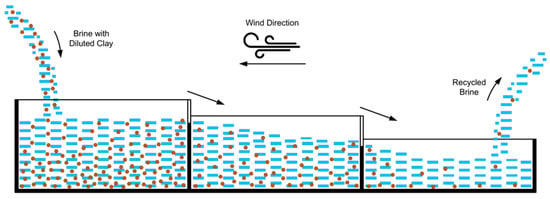
Figure 13.
The brine recycling process by decantation.
The salt washing process can be made more independent of the weather conditions because the washing machine and the small area decanter tanks can be installed under a large roof. Consequently, salt washing can be conducted at any time including in the winter, thus ensuring Cs3, and the workers assigned to the process could work in a much more friendly environment. During the winter, they would be protected from the rain, and the sun would not hit them directly during the summer.
Figure 14 shows the “brine cycle”, from the brine intake of the washing machine to the gathering of clay and other solid impurities at the decanter tanks. Then, the recycled brine returns to the washing machine to feed the process again. The recycled brine remains salt-saturated and still contains some clay, but high purity is not essential. Anyway, a small amount of clean or “virgin” brine is used to finish the washing process, as shown in the figure. Despite the mutual feeding, the operation of the two processes is completely independent. Washing and decantation are independent because they can run with any proportion of recycled brine and virgin brine, therefore, there is no feedback between both processes.
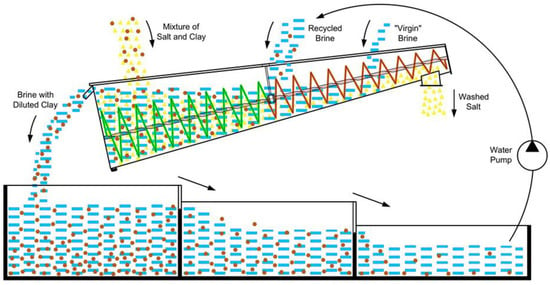
Figure 14.
The brine cycle in the salt washing process.
The zigzagging related to the salt production system including the brine production subsystem included at the third-level of decomposition is depicted in Figure 15.

Figure 15.
The decanting design in terms of AD.
Equation (7) relates to the third-level of the decomposition and shows that the design is an uncoupled solution at this level.
6. Results and Discussion
Equation (8) shows the design equation of the process up to the third-level of decomposition. The third-level corresponds to the decomposition of FR11 and FR12. The equation shows that the design is a decoupled design.
The new design has decoupled functions that allow for the speeds of the two screw conveyors to be consecutively adjusted. The new solution improved the separation and segregation functions, thus increasing the production by 20% to 30%. The solution improved the final quality of the product. The whiteness of the salt allowed us to evaluate the final perceived quality of the salt. A whiter salt means that it has fewer impurities than the darker salt. Moreover, the same amount of washed salt required less water and energy, following the CE objectives. Additionally, the new solution is socially more acceptable since it reduces the amount of hard work to produce the same quantity of washed salt, thus increasing the life cycle and performance of the process.
The production is mostly mechanized. In the day-to-day work, three people are needed; during salt collection, about ten. The new production reduced the time of exposure of the personnel to non-mechanized activities under weather conditions by 30%.
Therefore, retrofitting is a relevant point in the CE approach.
The proposed solution added one DP to the existing machine to control the separation and the washing functions in an uncoupled way. The final configuration of the new salt washing machine encompassed the division of the screw conveyor into two conveyors with independent rotation speeds, allowing for a higher rotation speed in the clay extraction section and a lower velocity in the salt segregation section. Moreover, it included a brine recycling process that avoids using virgin brine.
The salt flat to produce virgin brine was reduced from 68,200 m2 to 19,900 m2. This released about 48,000 m2, representing 70% of the original flat salt area. The 48,000 m2 of land free for other activities was about 10% of the total plant area (483,000 m2).
FR13 and FR14 were now decoupled and achieved by sequentially adjusting the speeds of the two screw conveyors. The new solution improved the separation and segregation functions while increasing the washing speed by 20% to 30%. The process productivity and the final quality of the product were also improved. Finally, the same amount of washed salt was obtained more efficiently, with less water, land area, and energy.
In terms of DSR, one can see that the activities were accomplished:
Activity 1 corresponds to the definition of the AD’s Customer Needs (the increment of productivity and sustainability of the salt washing process).
Activity 2 corresponds to the definition of the AD’s functional requirements and of their independence, which was conceptualized by the inclusion of a new design parameter.
Activity 3 corresponds to the proposed engineering solution that must obey the AD´s independence axiom. This was accomplished by adding the new DP14, as shown in Equation (6).
Activities 4 and 5 correspond, in practice, to evaluating that the process was operational, and that their objectives were achieved.
Activity 6 was expressed in a previous paper [1] and in the current paper, with the agreement of the owner of the industrial system.
7. Conclusions
Sustainability concerns the economy, environment, and society. The circular economy is a crucial strategy for sustainability. This paper proposes that sustainability should start at the design stage. This standpoint applies to the redesign or retrofit of products or processes. Axiomatic design (AD) allows for a design to be ruled by applying axioms, especially the independence axiom.
This paper presents an example of improving a salt washing process regarding sustainability. The improvement in the salt production took place in two steps: retrofitting the washing machine and adding the brine recycling subsystem. The revised design solution increased the salt production rate and reduced the resources needed, namely, saltwater, land area, and time.
The traditional washing machines used the same DP (the screw conveyor) to attain two functional requirements, so the number of DPs was smaller than the number of FRs. As per AD’s Theorem 1, the design was coupled, which is a poor design. The analysis of the design matrix in Equation (3) revealed this condition, which usually indicates the poor performance of the corresponding design solution.
The new design accomplished a decoupled design solution with a much better performance. The new DP was a second screw conveyor. Moreover, the new design recycled the dirty brine by decantation.
The new design solution reached the following benefits:
- -
- Improved productivity;
- -
- Reduced consumption of brine, water, and energy by about 30%;
- -
- Increased productivity by between 20% and 30%;
- -
- Increased perceived quality level of the final product;
- -
- Reduced weather dependency of the process;
- -
- Reduced land area use;
- -
- Improved quality of the working environment.
Axiomatic design allows for the analysis and identification of the origin of the problem, thus also allowing a better solution to be found that increased the productivity and improved the environmental sustainability, based on the AD’s independence axiom. This case was developed without the use of codes or algorithms, so it is not a “routine design”.
Finally, this paper contained some empirical evidence (as expected by the application of the AD’ theory) that decoupled designs are good solutions regarding efficiency, productivity, and sustainability. Since the development of this case study agrees with the DSR model, it has scientific value in the context of design science and science of the artificial.
Author Contributions
All of the authors contributed to the paper. Conceptualization and implementation, A.G.-S. and G.V.; Methodology, A.G.-S., M.C., A.M. (António Mourão) and A.G.-C.; Validation, A.G.-S. and A.M. (Alberto Martinho); Formal analysis, M.C., A.M. (António Mourão) and A.G.-C.; Investigation, A.G.-S., A.M. (Alberto Martinho) and J.F.; Resources, A.G.-S. and G.V.; Writing—original draft preparation, A.G.-S., G.V. and A.M. (António Mourão); Writing—review and editing, M.C., J.F. and A.G.-C.; Visualization, J.F.; Supervision, A.G.-C.; Project administration, A.M. (António Mourão) and A.G.-C. All authors have read and agreed to the published version of the manuscript.
Funding
This research was funded by FUNDAÇÃO PARA A CIÊNCIA E TECNOLOGIA, Portugal, grant number UIDB/00667/2020 (UNIDEMI).
Institutional Review Board Statement
Not applicable.
Informed Consent Statement
ICAD 2021 participants’ consent was waived for the reason that participation was voluntary and individual participants cannot be identified.
Data Availability Statement
Not applicable.
Acknowledgments
The authors thank the participants of the 14th International Conference on Axiomatic Design (ICAD 2021) that was held in Lisbon, Portugal, 23–25 June 2021, for their valuable comments when the preprint of reference [1] was presented.
Conflicts of Interest
The authors declare no conflict of interest. The funders had no role in the design of the study; in the collection, analyses, or interpretation of data; in the writing of the manuscript, or in the decision to publish the results.
References
- Gabriel-Santos, A.; Fradinho, J.; Mourão, A.; Martinho, A.; Cavique, M.; Vieira, G.; Gonçalves-Coelho, A. Increasing the performance of a Salt Washing Machine through Axiomatic Design. In IOP Conference Series: Materials Science and Engineering; IOP Publishing: Bristol, UK, 2021; Volume 1174, p. 012024. [Google Scholar] [CrossRef]
- McDonough, W.; Braungart, M. Cradle to Cradle: Remaking the Way We Make Things, 1st ed.; North Pole Press: New York, NY, USA, 2002; ISBN 0-86547-587-3. [Google Scholar]
- Ellen MacArthur Foundation and Granta Design. Circularity Indicators—An Approach to Measuring Circularity, Methodology. Available online: https://www.clmsostenible.es/wp-content/uploads/2019/02/Circularity-Indicators_Methodology_May2015.pdf (accessed on 23 December 2021).
- European Environment Agency; Gillabel, J.; De Schoenmaker, M. Circular by Design: Products in the Circular Economy; EEA Publications Office: Copenhagen, Denmark, 2017. [Google Scholar] [CrossRef]
- Vom Brocke, J.; Hevner, A.; Maedche, A. (Eds.) Introduction to Design Science Research. In Design Science Research. Cases; Springer: Cham, Switzerland, 2020. [Google Scholar] [CrossRef]
- Gabriel-Santos, A.; Gonçalves-Coelho, A.; Santos, P.; Fradinho, J.; Mourão, A. Redesigning a manufacturing system based on functional independence: The case of a tree nursery. Procedia CIRP 2015, 34, 206–211. [Google Scholar] [CrossRef] [Green Version]
- Shabazi, S.; Jönbrink, A.K. Design Guidelines to Develop Circular Products: Action Research on Nordic Industry. Sustainability 2020, 12, 3679. [Google Scholar] [CrossRef]
- Rocha, C.; Camacho, D.; Sampaio, J.; Alexandre, J. Product-Service Development for Circular Economy and Sustainability Course; Laboratório Nacional de Energia e Geologia: Lisboa, Portugal, 2020; ISBN 978-989-675-063-3. [Google Scholar]
- Saidani, M.; Kim, H.; Cluzel, F.; Leroy, Y.; Yannou, B. Product circularity indicators: What contributions in designing for a circular economy? In Proceedings of the Design Society: DESIGN Conference, Cavtat, Croatia, 26–29 October 2020; Volume 1, pp. 2129–2138. [Google Scholar] [CrossRef]
- Pigosso, D.; McAloone, T. How can design science contribute to a circular economy? In DS 87-2 Proceedings of the 21st International Conference on Engineering Design (ICED 17) Vol 2: Design Processes, Design Organisation and Management, Vancouver, Canada, 21–-25.08.2017; The Design Society: Glasgow, UK, 2017; ISBN 978-1-904670-93-3. [Google Scholar]
- Simon, H. The Sciences of the Artificial, 3rd ed.; MIT Press: Cambridge, MA, USA, 1996. [Google Scholar]
- Venable, J.R.; Pries-Heje, J.; Baskerville, R.L. Choosing a Design Science Research Methodology. In Proceedings of the Australasian Conference on Information Systems (ACIS 2017 Proceedings), Hobart, Australia, 4–6 December 2017; Volume 112. Available online: https://aisel.aisnet.org/acis2017/112 (accessed on 3 May 2022).
- Carstensen, A.-K.; Bernhard, J. Design science research—A powerful tool for improving methods in engineering education research. Eur. J. Eng. Educ. 2019, 44, 85–102. [Google Scholar] [CrossRef] [Green Version]
- Peffers, K.; Tuunanen, T.; Rothenberger, M.; Chatterjee, S. A Design Science Research Methodology for Information Systems Research. J. Manag. Inf. Syst. 2007, 24, 45–77. [Google Scholar] [CrossRef]
- Suh, N.P. Axiomatic Design: Advances and Applications; Oxford University Press: New York, NY, USA, 2001; ISBN 9780195134667. [Google Scholar]
- Gumus, B.; Ertas, A.; Tate, D.; Cicek, I. The Transdisciplinary Product Development Lifecycle Model. J. Eng. Des. 2008, 19, 185–200. [Google Scholar] [CrossRef]
- Suh, N.P. How Should We Select Functional Requirements? In Design Engineering and Science; Suh, N.P., Cavique, M., Foley, J., Eds.; Springer Nature: Cham, Switzerland, 2021; ISBN 978-3-030-49231-1. [Google Scholar]
- Suh, N.P. The Principles of Design; Oxford University Press: New York, NY, USA, 1990; ISBN 9780195043457. [Google Scholar]
- Suh, N.P. Complexity: Theory, and Applications; Oxford University Press: New York, NY, USA, 2005; ISBN 9780195178760. [Google Scholar]
- Tate, D. Axiomatic Design: Review, Impact, and Future Direction. In Proceedings of the ASME 2015 International Mechanical Engineering Congress and Exposition IMECE2015, Houston, TX, USA, 13–19 November 2015. [Google Scholar] [CrossRef]
- Nordlund., M.; Lee, T.; Kim, S.-G. Axiomatic Design: 30 Years After. In Proceedings of the ASME 2015 International Mechanical Engineering Congress and Exposition IMECE2015, Houston, TX, USA, 13–19 November 2015. [Google Scholar] [CrossRef] [Green Version]
Publisher’s Note: MDPI stays neutral with regard to jurisdictional claims in published maps and institutional affiliations. |
© 2022 by the authors. Licensee MDPI, Basel, Switzerland. This article is an open access article distributed under the terms and conditions of the Creative Commons Attribution (CC BY) license (https://creativecommons.org/licenses/by/4.0/).